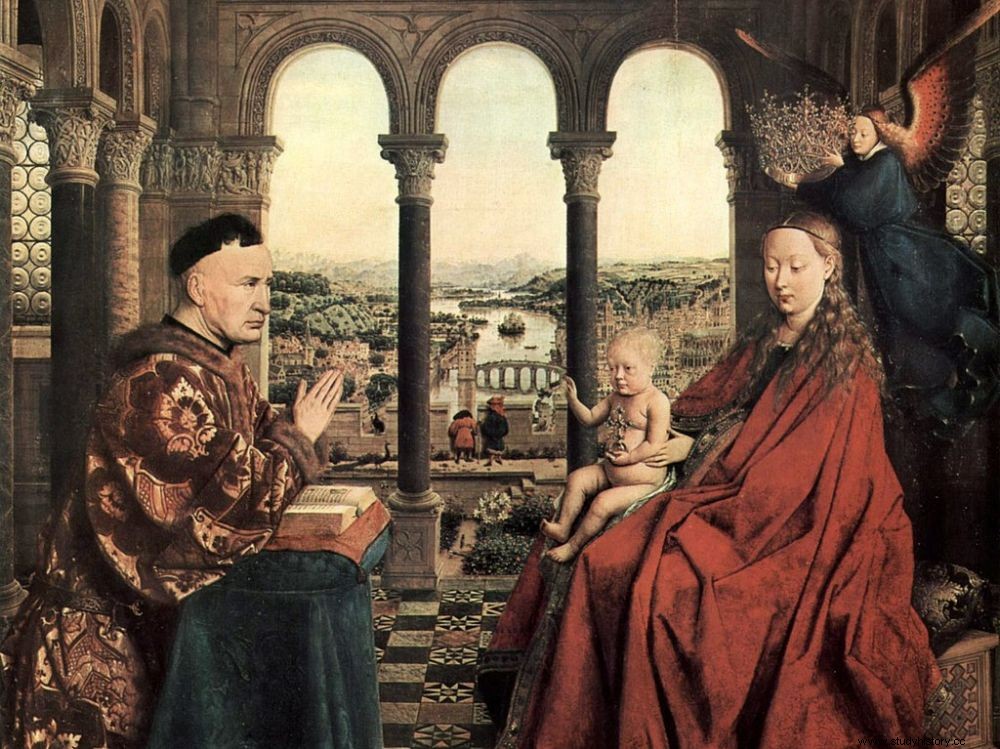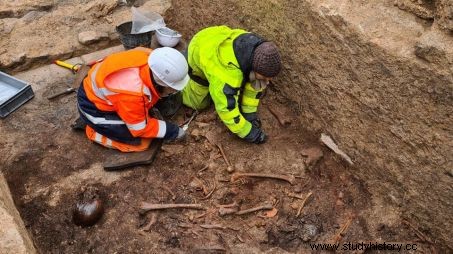Right arm of the Duke of Burgundy Philippe le Bon, Nicolas Rolin appears in a famous painting by Van Eyck. The discovery of the tomb of the founder of the Hospices de Beaune, who died in 1462, constitutes a remarkable new find in archaeology.

On the left, the Chancellor of the Duke of Burgundy Nicolas Rolin, on the right, a Virgin and Child. The painting was commissioned from the Flemish primitive van Eyck by Nicolas Rolin himself around 1435.
It is an exceptional discovery on the scale of the history of Burgundy, but also of France. The tomb of Chancellor Nicolas Rolin, right arm of Duke Philippe le Bon, but also founder of the famous Hospices de Beaune, has just been located during preventive excavations in Autun, in Saône-et-Loire. It is definitely a year rich in finds for the small town of Morvan, in which an important necropolis from Late Antiquity was also unearthed during the summer of 2020, undoubtedly one of the very first Christian cemeteries. of France.
A vault in the crypt of an old church
The tomb was found under Place Saint-Louis, which is currently being excavated for preventive purposes as part of the expansion project for the Autun city museum. The current Rolin Museum, located in the Hôtel Rolin, is none other than the former residence of the Chancellor, bequeathed by his father and dating from the 15th century. The museum in its future version, it will extend into the panoptic prison of the city, and will host the main entrance. It is precisely on its forecourt (the Place Saint-Louis, therefore) that the vault housing the bones of at least eight individuals, including those of Nicolas Rolin, suppose the archaeologists, was located. "It's a bit of a loop that comes full circle", entrusts to Science et Avenir Yannick Labaune, head of the city's archaeological service. "This vault is located just in front of the entrance to the future Rolin museum. It's as if he was telling us that he was keeping an eye on him."

Discovery of bones in the vault, under Place Saint-Louis. Credits:Archaeological service of the city of Autun
Until the 18th century, the Notre-Dame-de-Châtel church stood in this square, in which historical sources tell us that Chancellor Rolin was buried. "During Nicolas Rolin's lifetime, the church fell into ruins. He had it extensively restored and always kept a close link with it, since it was directly connected to his house by a footbridge. At the end of the latter there was a platform which allowed him to follow the masses. It was known that he had decided to be buried there in a tomb whose location is precisely indicated on old plans" , explains the archaeologist.
It is an exceptional discovery on the scale of the history of Burgundy, but also of France. The tomb of Chancellor Nicolas Rolin, right arm of Duke Philippe le Bon, but also founder of the famous Hospices de Beaune, has just been located during preventive excavations in Autun, in Saône-et-Loire. It is definitely a year rich in finds for the small town of Morvan, in which an important necropolis from Late Antiquity was also unearthed during the summer of 2020, undoubtedly one of the very first Christian cemeteries. of France.
A vault in the crypt of an old church
The tomb was found under Place Saint-Louis, which is currently being excavated for preventive purposes as part of the expansion project for the Autun city museum. The current Rolin Museum, located in the Hôtel Rolin, is none other than the former residence of the Chancellor, bequeathed by his father and dating from the 15th century. The museum in its future version, it will extend into the panoptic prison of the city, and will host the main entrance. It is precisely on its forecourt (the Place Saint-Louis, therefore) that the vault housing the bones of at least eight individuals, including those of Nicolas Rolin, suppose the archaeologists, was located. "It's a bit of a loop that comes full circle", entrusts to Science et Avenir Yannick Labaune, head of the city's archaeological service. "This vault is located just in front of the entrance to the future Rolin museum. It's as if he was telling us that he was keeping an eye on him."

Discovery of bones in the vault, under Place Saint-Louis. Credits:Archaeological service of the city of Autun
Until the 18th century, the Notre-Dame-de-Châtel church stood in this square, in which historical sources tell us that Chancellor Rolin was buried. "During Nicolas Rolin's lifetime, the church fell into ruins. He had it extensively restored and always kept a close link with it, since it was directly connected to his house by a footbridge. At the end of the latter there was a platform which allowed him to follow the masses. It was known that he had decided to be buried there in a tomb whose location is precisely indicated on old plans" , explains the archaeologist.
A golden spur as a clue
After the Revolution, the church was almost completely dismantled and its stones sold retail. "We expected while digging to find Notre-Dame-de-Châtel only a few centimeters from the ground. But in places, the stones had been torn up to the foundations! It is a miracle that we were able to find the vault, of which only one wall remains." Undoubtedly located at the level of the paving of the church, its access had to be done by a hatch. Inside, archaeologists first observed only a pile of rubble from the dismantling. "Removing this rubble, we were surprised to discover a very upset set of bones. We immediately thought of Nicolas Rolin, who we know was buried here with a specific type of clothing, a sword , a dagger and its two spurs (these small metal parts attached to the rider's heel and ending in a spiked wheel or a lug to prick the horse's flanks, editor's note)" , says Yannick Labaune. "We found no trace of clothing, dagger, or sword. But a spur, with traces of gilding. Those of Nicolas Rolin were gilded, the sources affirm it. let us think that his bones are indeed in this tomb. For once we have something in archeology that is consistent with the sources!" , rejoices the expert.
The small spur must now be sent to restoration and to the laboratory for further analysis. To try to find out with whom Nicolas Rolin was buried, it will also be necessary to carry out research in the archives. This should be done soon. Anthropological studies will also make it possible to specify the number of individuals, their age and possibly their state of health at the time of death.
Nicolas Rolin, wealthy politician
To say that Nicolas Rolin was a great political figure in Burgundy in the 15th century is an understatement. Born around 1376 and died on January 18, 1462 – at the very advanced age of 85 – he was successively lawyer of the Duke of Burgundy in the Parliament of Paris, chancellor of Philippe le Bon from 1422, and crowned Knight the year next. Widowed twice, he ended up marrying in 1423, in third marriage, the noble Comtoise Guigone de Salins, with whom he created in 1452 a new religious order, the Hospitaller Sisters of Beaune. Together, they built the magnificent Hôtel-Dieu de Beaune, a jewel of Flamboyant Gothic, "palace for the poor sick", refuge for the elderly, infirm and orphans. To adorn the place, he commissioned the impressive Polyptych of the Last Judgment from the Flemish painter Rogier van der Weyden. , and to Jan van Eyck a portrait of him praying, The Virgin of Chancellor Rolin , today preserved in the Louvre Museum. Extremely wealthy, he left dozens of lands, castles and other strongholds to his heirs at his death.
